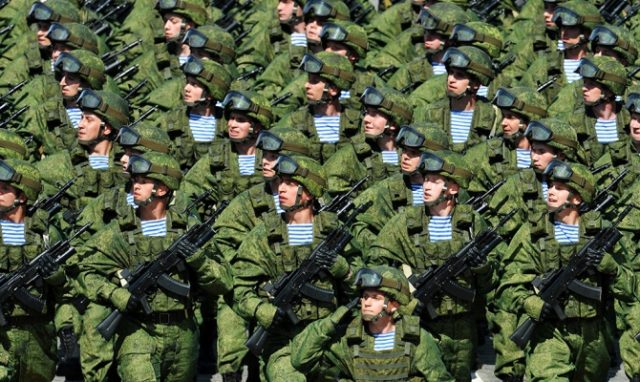
Russian Military Increasingly Consists of Seriously Undermanned Units
Publication: Eurasia Daily Monitor Volume: 16 Issue: 2
By:

Moscow has dramatically increased the number of divisions and brigades in its Armed Forces even as it has reduced the total size of its uniformed personnel. The result, independent Russian military analyst Aleksandr Golts says, is the return of the “paper divisions” that were characteristic of the last years of the Soviet Union (Openmedia.io, December 20, 2018). In such Soviet units, officers were in place but not the enlisted men who would have the experience and unit cohesion to make the military an effective fighting force. Now, Golts continues, the situation is even worse because junior officers will be forced to work de facto as non-coms (non-commissioned officers) and soldiers will not have the opportunity to master increasingly high-tech weapons systems.
By the end of 2019, Moscow will have formed 40 new brigades and divisions while cutting the size of its military. Thereby, the kind of “paper divisions” that plagued the authorities in the past—units that sound impressive but in fact are hollow shells incapable of performing their tasks—are being created yet again, the analyst says. The reason this is happening, the military observer argues, is that Russia has entered a new cold war against the United States, whose military budget is almost 20 times the size of Russia’s. As a result, Moscow has no possibility of responding except by creating these “paper” units.
At the end-of-the-year meeting of the defense ministry collegium, a session that Vladimir Putin attended as the supreme commander, Russian efforts looked impressive: the military announced it had formed ten new brigades and divisions this year and plans to form another 11 in 2019, bringing the total of new units created since 2014 to about 40 (Mil.ru, December 18, 2018). But despite the formation of these new units, Golts points out, the size of the Russian Armed Forces “not only has not grown but is declining.” Since 2015, the number of professional soldiers has not increased; and the size of the draft quota in 2018 compared to the previous year was smaller by 14,000 men (Openmedia.io, December 20, 2018).
Like in Soviet times, these new units are being staffed by officers. “Such regiments and divisions formed 80 percent of the Russian army before the [former defense minister Anatoly] Serdyukov reforms; and they were absolutely incapable of performing their mission,” as anyone could see from the Chechen wars and the military conflict with Georgia. Despite that failed past, “now ‘paper divisions’ evidently are returning. And with them low military preparedness,” Golts continues.
But that is hardly the only problem that the December meeting called attention to. Defense Minister Sergei Shoigu spoke about having met all his plans for rearming the military. But a comparison of his promises from a year ago with what he is saying now shows that this has not happened. “In 2018,” Golts says, “the forces were supposed to receive 203 planes and helicopters.” In fact, they obtained 126. Long-range aviation was supposed to acquire six new planes; it received five. The navy was supposed to gain 35 new ships; it took possession of only 25. Promised refittings were delayed. And so, “in the best case,” the Russian military fulfilled only about 70 percent of its goals.
These shortcomings are probably why Putin and Shoigu are holding such high-level meetings so frequently: they cannot count on the system to meet its goals and so are moving to take direct hands-on control of the situation. But they, too, appear to be under some illusions about what is possible given budgets. And they still regularly talk about developing “miracle” weapons.
Golts points out that “the leader of the state is not required to know everything, but someone has told him some obvious nonsense.” The Kremlin leader appears to think that the United States wants out of the short- and intermediate-range missile restrictions—imposed by the bilateral Intermediate-Range Nuclear Forces (INF) Treaty—because of cruise missiles on ships and planes. However, that simply is not true. Rather, the US is concerned about Russia’s land-based 9M729 Novator system. Moscow has put more of them into operation because it is “much cheaper” to install land-based rather than air- or sea-based ones (Openmedia.io, December 20, 2018). Putin’s remarks about the INF during last month’s defense ministry collegium represent a confirmation of US charges rather than a refutation (TASS, December 18, 2018).
This meeting of the defense ministry collegium was clearly intended to give Russians “the certainty that their security is under reliable protection. I fear,” Golts concludes, that “for an attentive reader, the effect produced is just the opposite” (Openmedia.io, December 20, 2018).
All that said, one should not conclude that the creation of these new and under-equipped paper divisions will make the Russian military wholly ineffective—particularly not against forces of some of Russia’s smaller neighboring countries. But it is important to underscore that those who take Russian propaganda about its military buildup at face value are deceiving themselves—which is exactly what the Kremlin hopes for. The new hollowness of the Russian Armed Forces should encourage observers in the West to similarly question the hollowness of other Moscow claims, instead of falling into the trap that Putin and Shoigu have laid for them.



